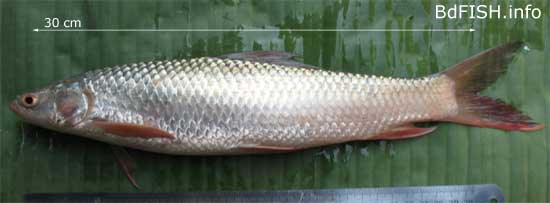
Synonyms:
Cyprinus mrigala Hamilton, 1822
Cirrhina mrigala Day, 1878
Cirrhina mrigala Shaw and Shebbeare, 1937
Cirrhina mrigala Bhuiyan, 1964
Cirrhina mrigala Ahmad, 1943
Cirrhinus mrigala mrigala Talwar and Jhingran, 1991
Common name: Caurvery white carp
Local name: Mrigel, Mirka
Taxonomy position:
Phylum- Chordata
Class-Oesteichthyes
Order-Cypriniformes
Family-Cyprinidae
Genus- Cirrhinus
Fin formula:
D. 16 (3/13); P1. 17; P2. 9 (1/8); A. 8(3/5). (Rahman, 2005)
Description of the species:
According to Rahman (1989), dorsal profile is more convex than that of abdomen. Snout obtusely rounded, covering upper lip and provide with proes. Upper lip is entire, not continuous with lower lip. Eye situated nearer to the end of the snout than the hind edge of operculum. Two pairs of nostrils present at anterior superior angle of orbits. A pair of rostral barbels present. Gill openings wide; gill rakers arranged at short intervals, caudal peduncle short, lateral line compete, scales hexagonal. Distance between pelvic and anal large, caudal deeply forked. Maximum length is 60 cm (Hamilton, 1822). Longest specimen in collection from the field is 35 cm.
Habit and Habitat:
It is a bottom feeder and it feeds on vegetables and small animals. The stomach contents include algae 20%, bits of higher plants 30%, protozoa 15%, crustacea 25%, mud and sands 10% (Bhuiyan, 1964). It usually does not take worms, insects, mollusks and fishes. River, rivulets, tanks and ponds are its main habitats.
Economic importance:
It is an important Indian major carp and quite a game fish. According to Talwar and Jhingran (1991), a large number of intergeneric hybrids have been produced at the central Inland Fisheries Research Institute, Barrackpore. This are-
| Male parent sp. | Female parent sp. | Hybrids |
| Catla catla | C. mrigala | Catla-mrigel |
| Labeo rohita | C. mrigala | Rohu-mrigel |
| C. mrigala | Labeo rohita | Mrigel-Rohu |
| C. mrigala | L. calbasu | Mrigel- L. calbasu |
Ecological role:
Mrigal is a detritus eater with a narrow range in food variety. It is a bottom feeder subsisting mainly on decayed vegetation (Talwar and Jhingran, 1991).
Status and conservation:
This fis is widely distributed throughout the Bangladesh. Not listed in IUCN red list as threatened. It breeds during May to July in shallow sections of selected rivers (Rahman, 1989). So, fishing in spawning ground and disturbance to the spawners should be avoided for conservation of the species.
References:
Ahmad, N. 1943. Fauna of Lahore. 5. Fishes of Lahore. Bull. Dept. Zool., Punjab Univ. .Lahore, p.276.
Bhuiyan, A. L. 1964. Fishes of Dacca. Asiatic Society of Pakistan, Dacca. p 28.
Day, F. 1878. Fishes of India, being a natural history of fishes known to inhabit the seas and freshwaters of India, Burma and Ceylon. William Dawson & Sons Ltd., London, Vol. I: p 557.
Hamilton, F., 1822. An account of the fishes found in the river Ganges and its branches, Edinburgh & London, Fishes Ganges, p 279.
IUCN Bangladesh. 2000. Red Book of Threatened Fishes of Bangladesh. IUCN- The World Conservation Union. xii+116 pp.
Rahman, A.K.A. 1989. Freshwater Fishes of Bangladesh. The Zoological Society of Bangladesh, Department of Zoology, University of Dhaka, Dhaka-1000. p 123.
Rahman, A.K.A. 2005. Freshwater Fishes of Bangladesh (Second edition). The Zoological Society of Bangladesh, Department of Zoology, University of Dhaka, Dhaka-1000. 394 pp.
Shaw and Shebbeare, 1937, The Fishes of Northern Bangal. Journal of Royal Asiatic Society of Bengal Science. p 45.
Talwar, P. K. and Jhingran, A. G., 1991. Inland Fishes of India and Adjacent Countries. Volume 1. Oxford & IBH Publishing Co. Pvt. Ltd. New Delhi, Calcutta. p 172.
Visited 5,936 times, 1 visits today | Have any fisheries relevant question?
